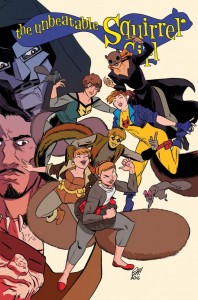 The Unbeatable Squirrel Girl #16 — Writers: Ryan North and Will Murray; Art: Erica Henderson; Colors: Rico Renzi
The Unbeatable Squirrel Girl #16 — Writers: Ryan North and Will Murray; Art: Erica Henderson; Colors: Rico Renzi
The Mighty Thor #15 — Writer: Jason Aaron; Art: Russell Dauterman; Colors: Matthew Wilson
Ms. Marvel #14 — Writer: G. Willow Wilson; Art: Takeshi Miyazawa; Colors: Ian Herring
Jessica Jones #4 — Writer: Brian Michael Bendis; Art: Michael Gaydos; Colors: Matt Hollingsworth
As so often lately, we’re starting with the Marvel women heroes, because they’re currently starring in some of the most innovative and fun comics. Squirrel Girl is celebrating its 25th anniversary. How is that possible for a book that 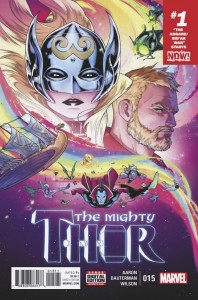 just started two years ago? As the editorial material on the letters page explains, that’s because Doreen’s origin and first appearance was in a short feature in Marvel Super-Heroes Winter Special, in 1991, written by Will Murray and drawn by Steve Ditko (!!). Befitting an anniversary story, this looks in on her at birth, and then at the ages of five, ten, fifteen and twenty (where she is “now”), with a one-page coda set five years in the future, too (they even invited original writer Murray to script the six-page “fifteen-year-old” sequence, involving a team-up with the Hulk). Overall creators North and Henderson, as always, deliver a smart, funny and very likeable story; I could look at Henderson’s uniquely-modern, cartoony style all day (the last panel of the “now” sequence, featuring Loki, made me laugh out loud, because his expression is so perfect), while North’s very-small-print asides at the bottoms of the pages are worth the entry
just started two years ago? As the editorial material on the letters page explains, that’s because Doreen’s origin and first appearance was in a short feature in Marvel Super-Heroes Winter Special, in 1991, written by Will Murray and drawn by Steve Ditko (!!). Befitting an anniversary story, this looks in on her at birth, and then at the ages of five, ten, fifteen and twenty (where she is “now”), with a one-page coda set five years in the future, too (they even invited original writer Murray to script the six-page “fifteen-year-old” sequence, involving a team-up with the Hulk). Overall creators North and Henderson, as always, deliver a smart, funny and very likeable story; I could look at Henderson’s uniquely-modern, cartoony style all day (the last panel of the “now” sequence, featuring Loki, made me laugh out loud, because his expression is so perfect), while North’s very-small-print asides at the bottoms of the pages are worth the entry  price by themselves (he’s mastered the art of being simultaneously humorous and inspiring without descending into annoying or preachy, which is a lot harder than it looks). This book is the future of comics (well, “a” future), because it’s introducing and addicting new readers to the medium; we should all be buying extra copies and giving them to as many younger potential fans as we can. Ms. Marvel has a similar attraction, with its confident young American-Muslim heroine; showing how much Kamala is like any geeky teen fangirl (much of this issue involves her online roleplaying, which bleeds into the “real” world with disastrous consequences) does more to promote tolerance and diversity — without ever using those words — than a dozen high-school workshops or assemblies. The Mighty Thor continues the adventures of the cancer-stricken Jane Foster as the hammer-wielder, and, while it’s much more mainstream-superhero than Squirrel Girl, or even Ms. Marvel, its combination of Aaron’s large-
price by themselves (he’s mastered the art of being simultaneously humorous and inspiring without descending into annoying or preachy, which is a lot harder than it looks). This book is the future of comics (well, “a” future), because it’s introducing and addicting new readers to the medium; we should all be buying extra copies and giving them to as many younger potential fans as we can. Ms. Marvel has a similar attraction, with its confident young American-Muslim heroine; showing how much Kamala is like any geeky teen fangirl (much of this issue involves her online roleplaying, which bleeds into the “real” world with disastrous consequences) does more to promote tolerance and diversity — without ever using those words — than a dozen high-school workshops or assemblies. The Mighty Thor continues the adventures of the cancer-stricken Jane Foster as the hammer-wielder, and, while it’s much more mainstream-superhero than Squirrel Girl, or even Ms. Marvel, its combination of Aaron’s large-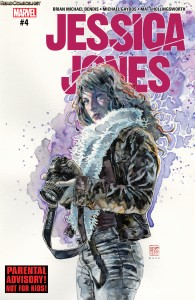 scale cosmic stories (in this issue, the Shi’ar, led by their Justice League-like Imperial Guard — including Gladiator, their Superman avatar — invade Asgard) and Dauterman’s sleek, character-centric art makes it hard to resist. That leaves Jessica Jones, riding a wave of TV-induced publicity; this issue of her relaunch, by original creators Bendis and Gaydos, explains her current downtrodden situation (just out of jail, separated from her husband Luke Cage, and trying to scrape by on low-level PI work), in a way that’s both satisfying and true to her character, and should make both old-time fans and newer readers attracted from the Netflix series equally happy.
scale cosmic stories (in this issue, the Shi’ar, led by their Justice League-like Imperial Guard — including Gladiator, their Superman avatar — invade Asgard) and Dauterman’s sleek, character-centric art makes it hard to resist. That leaves Jessica Jones, riding a wave of TV-induced publicity; this issue of her relaunch, by original creators Bendis and Gaydos, explains her current downtrodden situation (just out of jail, separated from her husband Luke Cage, and trying to scrape by on low-level PI work), in a way that’s both satisfying and true to her character, and should make both old-time fans and newer readers attracted from the Netflix series equally happy.
 Spider-Man #12 — Writer: Brian Michael Bendis; Art: Sara Pichelli; Ink Assist: Gaetano Carlucci; Colors: Justin Ponsor
Spider-Man #12 — Writer: Brian Michael Bendis; Art: Sara Pichelli; Ink Assist: Gaetano Carlucci; Colors: Justin Ponsor
Guardians of the Galaxy #16 — Writer: Brian Michael Bendis; Art: Valerio Schiti; Colors: Richard Isanove
Rocket Raccoon #2 — Writer: Matthew Rosenberg; Art: Jorge Coelho; Colors: Antonio Fanelas
Spider-Man/Deadpool #13 — Writer: Joe Kelly; Pencils: Ed McGuinness; Inks: Mark Morales, John Dell and Ed McGuiness; Colors: Jason Keith
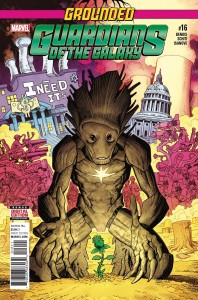 The Uncanny Avengers #19 — Writer: Gerry Duggan; Art: Pepe Larraz with Roderigo Zayas; Colors: Dono Sanchez Almara
The Uncanny Avengers #19 — Writer: Gerry Duggan; Art: Pepe Larraz with Roderigo Zayas; Colors: Dono Sanchez Almara
Inhumans vs. X-Men #2 (of 6) — Writers: Jeff Lemire and Charles Soule; Pencils: Leonil Francis Yu; Inks: Gerry Alanguilan; Colors: David Curiel
Jessica Jones is only the first of a trio of comics written by Bendis out this week. Spider-Man has Miles Morales getting tracked down by Maria Hill and assigned to rescue his father, an undercover S.H.I.E.L.D. agent who’s gotten trapped in an alternate dimension (just another occupational  hazard for Marvel universe inhabitants), which leads to a meeting with that Earth’s spider-hero, Gwen Stacy (and a crossover with next week’s Spider-Gwen #16); it’s as entertaining and charmingly-drawn as all the Bendis/Pichelli episodes of this character have been. Guardians of the Galaxy continues the grounded-on-Earth arc by spotlighting Groot, in a change-of-pace comic that reads like a Dr. Seuss-ish children’s book, told with full-page illustrations and rhyming dialogue; that dialogue doesn’t always scan for rhythm very precisely, but points for trying — and if you know any fans of the big woody galoot, they’ll love this issue. Turning to non-Bendis but still-Guardians
hazard for Marvel universe inhabitants), which leads to a meeting with that Earth’s spider-hero, Gwen Stacy (and a crossover with next week’s Spider-Gwen #16); it’s as entertaining and charmingly-drawn as all the Bendis/Pichelli episodes of this character have been. Guardians of the Galaxy continues the grounded-on-Earth arc by spotlighting Groot, in a change-of-pace comic that reads like a Dr. Seuss-ish children’s book, told with full-page illustrations and rhyming dialogue; that dialogue doesn’t always scan for rhythm very precisely, but points for trying — and if you know any fans of the big woody galoot, they’ll love this issue. Turning to non-Bendis but still-Guardians  comics, there’s Rocket Raccoon, wherein the bad-tempered, deceptively-cute-but-deadly space mammal tries to survive on Earth; his attempts to get off the planet, cynical takes on modern American life and encounters with various Marvel luminaries (including the Miles Morales Spider-Man again) make this read like an early Howard the Duck comic, with Coelho’s busy, crosshatchy art handling the various aliens, heroes, villains and standard-issue crazy humans with clarity and style. Spider-Man/Deadpool continues to be much better than the cash-grab concept might suggest, largely due to writer Joe Kelly, who’s been around a long time (both he and artist McGuiness were on Wade
comics, there’s Rocket Raccoon, wherein the bad-tempered, deceptively-cute-but-deadly space mammal tries to survive on Earth; his attempts to get off the planet, cynical takes on modern American life and encounters with various Marvel luminaries (including the Miles Morales Spider-Man again) make this read like an early Howard the Duck comic, with Coelho’s busy, crosshatchy art handling the various aliens, heroes, villains and standard-issue crazy humans with clarity and style. Spider-Man/Deadpool continues to be much better than the cash-grab concept might suggest, largely due to writer Joe Kelly, who’s been around a long time (both he and artist McGuiness were on Wade 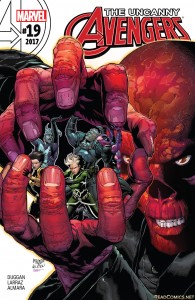 Wilson’s original run back in the ’90s), and is able to (a) nail all that dialogue required for two such motor-mouthed characters, and (b) keep the twists and turns of their tentative bromance interesting and logical, while maintaining their core personalities. Uncanny Avengers continues a climactic fight with the Red Skull (powered by Professor X’s stolen brain) going on, with Deadpool again front and center, as he scrambles for help after most of the rest of the team is compromised; for the first time in a while, it feel like the events in this comic are significant, and important to the rest of the Marvel universe. You’d think that would be true of Inhumans vs X-Men, too, but despite all the characters and fighting and possible death (if the X-Men don’t get rid of that
Wilson’s original run back in the ’90s), and is able to (a) nail all that dialogue required for two such motor-mouthed characters, and (b) keep the twists and turns of their tentative bromance interesting and logical, while maintaining their core personalities. Uncanny Avengers continues a climactic fight with the Red Skull (powered by Professor X’s stolen brain) going on, with Deadpool again front and center, as he scrambles for help after most of the rest of the team is compromised; for the first time in a while, it feel like the events in this comic are significant, and important to the rest of the Marvel universe. You’d think that would be true of Inhumans vs X-Men, too, but despite all the characters and fighting and possible death (if the X-Men don’t get rid of that 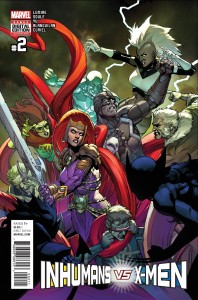 darned terrigen cloud in two weeks, all the mutants on Earth are going to die), it just doesn’t feel very high-stakes — maybe because we know about all of the new X-books coming out in spring, after this is over. It’s still fun watching the combat-strategy chess-match between the two teams, though, especially because Lemire and Soule are good at that sort of thing; in the first issue, we saw events from mutant master-planner Emma Frost’s point of view, while in this episode the focus is on Medusa and her family of Inhumans. The book’s every-two-week schedule also helps, providing chapters quickly enough that readers won’t get bored waiting for closure.
darned terrigen cloud in two weeks, all the mutants on Earth are going to die), it just doesn’t feel very high-stakes — maybe because we know about all of the new X-books coming out in spring, after this is over. It’s still fun watching the combat-strategy chess-match between the two teams, though, especially because Lemire and Soule are good at that sort of thing; in the first issue, we saw events from mutant master-planner Emma Frost’s point of view, while in this episode the focus is on Medusa and her family of Inhumans. The book’s every-two-week schedule also helps, providing chapters quickly enough that readers won’t get bored waiting for closure.
 Justice League of America: Vixen — Rebirth #1 (of 1) — Writers: Steve Orlando and Jody Houser; Art/Colors: Jamal Campbell
Justice League of America: Vixen — Rebirth #1 (of 1) — Writers: Steve Orlando and Jody Houser; Art/Colors: Jamal Campbell
Justice League/Power Rangers #1 (of 6) — Writer: Tom Taylor; Art/Colors: Stephen Byrne
Justice League/Suicide Squad #4 (of 6) — Writer: Joshua Williamson; Pencils: Fernando Pasarin; Inks: Matt Ryan; Colors: Alex Sinclair with Jeremy Skipper
 Suicide Squad #9 — Writers: Rob Williams and Si Spurrier; Art: Riley Rossmo; Colors: Ivan Plascencia
Suicide Squad #9 — Writers: Rob Williams and Si Spurrier; Art: Riley Rossmo; Colors: Ivan Plascencia
All-Star Batman #6 — Writer: Scott Snyder; Art: Jock; Colors: Matt Hollingsworth
Hal Jordan and the Green Lantern Corps #12 — Writer: Robert Venditti; Art: Ethan Van Sciver; Colors: Jason Wright
 You can tell that the Justice League, the Suicide Squad, Batman and Harley Quinn are DC’s big guns right now; they account for all but one of the books on this list, although Vixen — Rebirth only focuses on that one character (she’s part of the upcoming Justice League of America team, so she gets this one-shot origin, as did the Ryan Choi Atom last week; upcoming stand-alone issues will focus on the other members of the group: The Ray, Black Canary, Batman, Killer Frost (!) and Biker Lobo (!!). Justice League/Power Rangers, like
You can tell that the Justice League, the Suicide Squad, Batman and Harley Quinn are DC’s big guns right now; they account for all but one of the books on this list, although Vixen — Rebirth only focuses on that one character (she’s part of the upcoming Justice League of America team, so she gets this one-shot origin, as did the Ryan Choi Atom last week; upcoming stand-alone issues will focus on the other members of the group: The Ray, Black Canary, Batman, Killer Frost (!) and Biker Lobo (!!). Justice League/Power Rangers, like 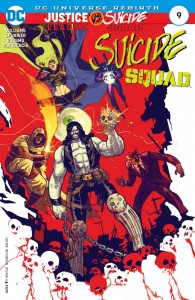 Batman/Teenage Mutant Ninja Turtles, pretty much tells you everything you need to know just with its title; this first issue gets the two groups together (thanks to a malfunctioning, dimension-spanning transporter) and of course they mistake each others’ intentions, and start a fight to carry over into the next issue, but, really: you’ve either already decided to buy this based on the concept, or not, so describing its decent-enough execution is probably beside the point. Justice League vs Suicide Squad continues to motor along nicely, with the plot at the “both groups team up to fight the larger menace”
Batman/Teenage Mutant Ninja Turtles, pretty much tells you everything you need to know just with its title; this first issue gets the two groups together (thanks to a malfunctioning, dimension-spanning transporter) and of course they mistake each others’ intentions, and start a fight to carry over into the next issue, but, really: you’ve either already decided to buy this based on the concept, or not, so describing its decent-enough execution is probably beside the point. Justice League vs Suicide Squad continues to motor along nicely, with the plot at the “both groups team up to fight the larger menace” 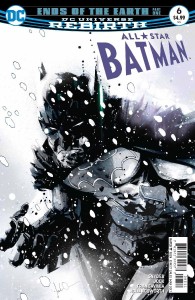 stage, the menace being Max Lord, who’s after an artifact that, of course, manages to up the stakes even more, while leading to another last-page cliffhanger (Williamson’s been very good with those so far, and the book’s quick schedule — it outdoes Inhumans vs. X-Men by being a weekly series — makes the following-issue payoffs even better). Suicide Squad #9 offers the inevitable tie-in to the JL/SS mini-series, by focusing on the tale of the “first” Suicide Squad — Lobo, Emerald Empress, Johnny Sorrow, Rustam, and Doctor Polaris — and why they were originally assembled by Amanda Waller, and now have teamed up with Lord to kill her; bonus points for the Riley Rossmo art, since he brings just enough of an indy sheen to the book
stage, the menace being Max Lord, who’s after an artifact that, of course, manages to up the stakes even more, while leading to another last-page cliffhanger (Williamson’s been very good with those so far, and the book’s quick schedule — it outdoes Inhumans vs. X-Men by being a weekly series — makes the following-issue payoffs even better). Suicide Squad #9 offers the inevitable tie-in to the JL/SS mini-series, by focusing on the tale of the “first” Suicide Squad — Lobo, Emerald Empress, Johnny Sorrow, Rustam, and Doctor Polaris — and why they were originally assembled by Amanda Waller, and now have teamed up with Lord to kill her; bonus points for the Riley Rossmo art, since he brings just enough of an indy sheen to the book  to keep it from seeming too cookie-cutter or thrown-together. All-Star Batman sees Scott Snyder beginning a new arc, this time with Mr. Freeze and art by Jock; you don’t really need to know any more than that to buy this comic. Hal Jordan and the Green Lantern Corps has finally brought all its major players — Hal, John, Kyle and Guy, along with the rest of the GLC and the kind-of-reformed Sinestro Corps — together to battle the greed-infected Larfleeze; bonus points here for one of his bottled acquisitions being the Emo Lobo, who, judging by Biker Lobo’s presence in the JL/SS mini-series and in the upcoming Justice League of America, won’t be escaping any time soon.
to keep it from seeming too cookie-cutter or thrown-together. All-Star Batman sees Scott Snyder beginning a new arc, this time with Mr. Freeze and art by Jock; you don’t really need to know any more than that to buy this comic. Hal Jordan and the Green Lantern Corps has finally brought all its major players — Hal, John, Kyle and Guy, along with the rest of the GLC and the kind-of-reformed Sinestro Corps — together to battle the greed-infected Larfleeze; bonus points here for one of his bottled acquisitions being the Emo Lobo, who, judging by Biker Lobo’s presence in the JL/SS mini-series and in the upcoming Justice League of America, won’t be escaping any time soon.
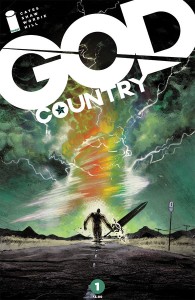 God Country #1 — Writer: Donny Gates; Art: Geoff Shaw; Colors: Jason Wordie
God Country #1 — Writer: Donny Gates; Art: Geoff Shaw; Colors: Jason Wordie
The Rift #1 (of 4) — Writers: Don Handfield and Richard Raynor; Art: Leno Carvalho; Colors: Rodrigo Fernandes
Sherlock: The Blind Banker #1 (of 6) — Script: Steve Thompson; Adaptation: Jay
The Assignment #1 — Story and Screenplay: Walter Hill and Denis Hamill; Adaptation: Matz; Art: Jef; Translation: Charles Ardai
 Of the indy debuts, God Country starts out seeming to be Texas noir, involving a senile-but-powerful old man and his son’s struggle to decide what to do about him, but then twists around, interprets the title more literally, and becomes yet another fantasy/sf Image title — a good one, too, with the grounded beginning getting us to care about the characters before the bigger cosmic fireworks start, and a bookend/storyteller framing device that enhances the book’s mythic tone. The Rift is about a hole that opens in the sky and emits a WWII-era bomber that immediately crashes, in front of a woman and her son driving to start a new life on the other side of the country; what happens to them and
Of the indy debuts, God Country starts out seeming to be Texas noir, involving a senile-but-powerful old man and his son’s struggle to decide what to do about him, but then twists around, interprets the title more literally, and becomes yet another fantasy/sf Image title — a good one, too, with the grounded beginning getting us to care about the characters before the bigger cosmic fireworks start, and a bookend/storyteller framing device that enhances the book’s mythic tone. The Rift is about a hole that opens in the sky and emits a WWII-era bomber that immediately crashes, in front of a woman and her son driving to start a new life on the other side of the country; what happens to them and 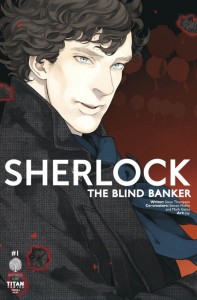 the plane’s pilot is the core of the tale. Here, the bonus points are for giving the seemingly-tyrranical men-in-black government agents a good reason for their actions, instead of just turning them into cardboard villains; for making us care about the central characters; and for making this just a four-issue series, which promises a closure that makes it a lot easier to come back for the next three issues. Sherlock: The Blind Banker is a reprint of the second Japanese/manga adaptation of an episode from the British TV series; it stays very close to the original script, and is skilled enough to be worth a look even if you’re not a Benedict Cumberbatch (or Steven Moffat) fan — but if you are, you’ll definitely enjoy this. The Assignment has a tangled history: it’s based on a film-noir story that director Walter Hill (The Warriors; 48 Hours) bought and
the plane’s pilot is the core of the tale. Here, the bonus points are for giving the seemingly-tyrranical men-in-black government agents a good reason for their actions, instead of just turning them into cardboard villains; for making us care about the central characters; and for making this just a four-issue series, which promises a closure that makes it a lot easier to come back for the next three issues. Sherlock: The Blind Banker is a reprint of the second Japanese/manga adaptation of an episode from the British TV series; it stays very close to the original script, and is skilled enough to be worth a look even if you’re not a Benedict Cumberbatch (or Steven Moffat) fan — but if you are, you’ll definitely enjoy this. The Assignment has a tangled history: it’s based on a film-noir story that director Walter Hill (The Warriors; 48 Hours) bought and 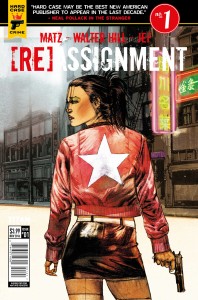 turned into both an indy movie (called (Re)Assignment) and a French graphic novel, which has now been translated into English and published here by Titan Comics. The plot involves a hitman who’s captured and knocked out; when he wakes up, he’s been surgically turned into a woman (played by Michelle Rodriguez in the film). Using the involuntary-transgender twist to power a pulpy low-budget thriller did not exactly endear Hill to the LGBT community, but if you’d like to see what the fuss was about without actually having to watch the movie (and, to be fair, the art by Matz makes it all look suitably flashy and low-rent), then here you go.
turned into both an indy movie (called (Re)Assignment) and a French graphic novel, which has now been translated into English and published here by Titan Comics. The plot involves a hitman who’s captured and knocked out; when he wakes up, he’s been surgically turned into a woman (played by Michelle Rodriguez in the film). Using the involuntary-transgender twist to power a pulpy low-budget thriller did not exactly endear Hill to the LGBT community, but if you’d like to see what the fuss was about without actually having to watch the movie (and, to be fair, the art by Matz makes it all look suitably flashy and low-rent), then here you go.
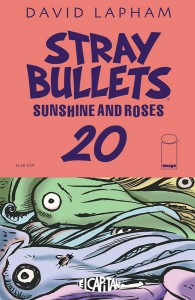 Stray Bullets: Sunshine and Roses #20 — Writer/Artist: David Lapham
Stray Bullets: Sunshine and Roses #20 — Writer/Artist: David Lapham
Southern Bastards #16 — Writer: Jason Aaron; Art/Colors: Jason Latour
Moonshine #4 — Writer: Brian Azzarello; Art/Colors: Eduardo Risso
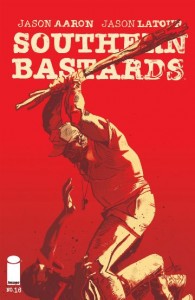 Violent Love #3 — Writer: Frank J. Barbiere; Art/Colors: Victor Santos
Violent Love #3 — Writer: Frank J. Barbiere; Art/Colors: Victor Santos
Half of the indy books left are in the noir/crime/suspense genre; Stray Bullets actually takes a break from its grifters-on-the-run regular tale to do an Amy Racecar story — and then turns  around and shows us exactly where they’ve been coming from all these years (in a way that makes me wonder if the character of Beth is long for this world…). Southern Bastards sees its Deep-South high-school football Coach Boss going off the deep end trying to keep from losing three games in a row, and I’d compliment Latour’s art by calling it “stylized” except that Moonshine #4 has
around and shows us exactly where they’ve been coming from all these years (in a way that makes me wonder if the character of Beth is long for this world…). Southern Bastards sees its Deep-South high-school football Coach Boss going off the deep end trying to keep from losing three games in a row, and I’d compliment Latour’s art by calling it “stylized” except that Moonshine #4 has 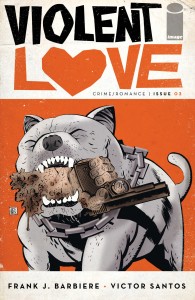 really stylized art by Eduardo Risso, with moonshiners, mobsters, werewolves and naked women thrown into the mix; both artists do their own coloring, and it gives their panels a bright, unified energy that just jumps off the page. Violent Love, meanwhile, features Victor Santos rendering Frank Barbiere’s extreme violence in Will Eisner/Darwyn Cooke style, allowing its slow-burning Bonnie and Clyde tale the same grim, inevitable reap-what-you-sow clarity that distinguishes the other books on this list.
really stylized art by Eduardo Risso, with moonshiners, mobsters, werewolves and naked women thrown into the mix; both artists do their own coloring, and it gives their panels a bright, unified energy that just jumps off the page. Violent Love, meanwhile, features Victor Santos rendering Frank Barbiere’s extreme violence in Will Eisner/Darwyn Cooke style, allowing its slow-burning Bonnie and Clyde tale the same grim, inevitable reap-what-you-sow clarity that distinguishes the other books on this list.
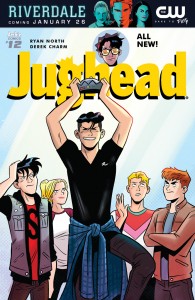 Jughead #12 — Writer: Ryan North; Art/Colors: Derek Charm
Jughead #12 — Writer: Ryan North; Art/Colors: Derek Charm
Groo: Fray of the Gods #4 (of 4) — Writer/Artist: Sergio Aragones; Wordsmith: Mark Evanier; Colors: Tom Luth
Shadows on the Grave #2 — Creator: Richard Corben
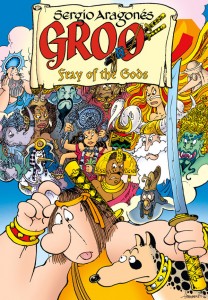 Shipwreck #3 — Writer: Warren Ellis; Pencils: Phil Hester; Inks: Eric Gapstur; Colors: Mark Englert
Shipwreck #3 — Writer: Warren Ellis; Pencils: Phil Hester; Inks: Eric Gapstur; Colors: Mark Englert
What puts these last four books on the list? Jughead has Reggie defeating the gang, specifically Jughead, in a series of video go-kart games and demanding increasing tribute for it; the 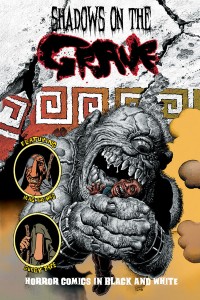 script by Ryan North is almost as clever and cocky as its antagonist (if not at the level of his Squirrel Girl books), and the Derek Charm art is almost as good as Henderson at nailing the various facial expressions to emphasize humor, sarcasm and, sometimes, compassion. Groo ends its “Fray of the Gods” mini-series with the usual perfect art and pointed, timely allegory about worship and power,
script by Ryan North is almost as clever and cocky as its antagonist (if not at the level of his Squirrel Girl books), and the Derek Charm art is almost as good as Henderson at nailing the various facial expressions to emphasize humor, sarcasm and, sometimes, compassion. Groo ends its “Fray of the Gods” mini-series with the usual perfect art and pointed, timely allegory about worship and power,  while Shadows on the Grave continues to let Richard Corben wield his expert airbrush and channel his inner EC horror fan, while throwing in some Greek mythology too. Shipwreck is one of those Warren Ellis stories revolving around a stranger wandering through a strange land; the reason for the surreal landscape — and the broken thoughts of its main character — get revealed in this issue, and it’s yet another transporter/alternate dimensions device (they call it an “apporter”) gone horribly wrong: bad for that main character, but good for the readers, since the eerie tone and slow reveal make for a good comic.
while Shadows on the Grave continues to let Richard Corben wield his expert airbrush and channel his inner EC horror fan, while throwing in some Greek mythology too. Shipwreck is one of those Warren Ellis stories revolving around a stranger wandering through a strange land; the reason for the surreal landscape — and the broken thoughts of its main character — get revealed in this issue, and it’s yet another transporter/alternate dimensions device (they call it an “apporter”) gone horribly wrong: bad for that main character, but good for the readers, since the eerie tone and slow reveal make for a good comic.



